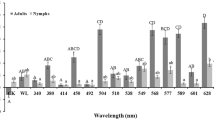Abstract
The valence of horizontally incidenting light/optical radiation for host-seeking-inclined ixodid ticks was investigated by exposing male and female adults ofRhipicephalus evertsi mimeticus andHyalomma truncatum to narrow-band monochromatic radiation in the wavelength range of 300–801 nm at irradiances corresponding to an overcast to clear sunny day, a cloudy day and a full-moon night as well as to optical radiation of a sun-simulating wavelength spectrum of 190–2600 nm within a test chamber from which other stimuli were excluded. It was demonstrated that independent of sex, adult ticks ofR. e. mimeticus andH. truncatum responded to a wide wavelength spectrum in the visible and UV range, even at irradiances corresponding to a full-moon night. Interspecific differences existed in the degree and extent of the response as well as in the spectral sensitivity. Ticks ofH. truncatum consistently showed a faster and stronger response and reacted phototactically positively in higher percentages than adults ofR. e. mimeticus. Independent of wavelength range and irradiance, predominantly only fewR. e. mimeticus ticks were stimulated to positive phototaxis, whereas at least 33.3% (in most cases, 50%) and maximally >80% ofH. truncatum adults reacted phototactically positively. Spectral sensitivity maxima were demonstrated at the yellow and red light and at the UV-A waveband width forR. e. mimeticus and at the violet, blue, green and yellow light wavelength forH. truncatum. With decreasing irradiance, the spectral sensitivity shifted to the blue wavelength range.
In the search for adequate blood donors, ticks are confronted with numerous natural stimuli, which must be sorted and processed and are possibly used selectively if a host is to be located successfully. The questions as to whether and to what extent optical radiation may precipitate a reaction and/or an orientationally determining influence on ticks has been only partially and insufficiently investigated. Studies on two-host ixodid species of ticks that inhabit the same regions south of the Sahara have not been performed at all in this regard. Accordingly, the present study was intended to investigate the reactions of hungry male and female ticks ofRhipicephalus evertsi mimeticus andHyalomma truncatum to horizontally incidenting monochromatic radiation of various wavelength sectors and irradiances and to optical radiation of a sun-simulating spectral range.
Similar content being viewed by others
References
Carroll JF, Pickens LG (1986) Ticks react to colors to hitch a ride. USDA News Feature. News Division, U.S. Department of Agriculture, Washington, D.C.
Carroll JF, Pickens LG (1987) Spectral sensitivity to light of two species of ticks (Acarina: Ixodidae). Ann Entomol Soc Am 80:256–262
Estrada-Peña A, Sanchez-Acedo C (1988) Studies on activity ofRhipicephalus (Digeneus) bursa (Acarina: Ixodidae) under natural conditions. Acarologia 29:267–274
Gothe R, Koch B, Leuterer G (1989) Zur Sensitivität vonArgas (Persicargas) walkerae auf optische Strahlung sowie zur Lokalisation und Organisation lichtperzipierender oder durchlässiger Areale des Integumentes. J Vet Med [B] 36:303–313
Kaltenrieder M, Labhart T, Hess E (1988) Spektrale Empfindlichkeit und Sehfeld der ZeckenartenHyalomma dromedarii undAmblyomma variegatum. Kurzfassung der 13. Tagung der Deutschen Gesellschaft für Parasitologie, Neuchatel, March, 22–25
Kaltenrieder M, Labhart T, Hess, E (1989) Spectral sensitivity, absolute threshold, and visual field of two tick species,Hyalomma dromedarii andAmblyomma variegatum. J Comp Physiol [A] 165:155–164
Author information
Authors and Affiliations
Additional information
Dedicated to Prof. Dr. J. Eckert on the occasion of his 60th birthday
Rights and permissions
About this article
Cite this article
Leuterer, G., Gothe, R. On the reaction of adultRhipicephalus evertsi mimeticus andHyalomma truncatum to horizontally incidenting optical radiation of various wavelength ranges and different irradiances and to optical radiation of a sun-simulating wavelength spectrum. Parasitol Res 77, 353–358 (1991). https://doi.org/10.1007/BF00930915
Accepted:
Issue Date:
DOI: https://doi.org/10.1007/BF00930915




